Risk Level determination: Capacity Assessment and Performance Index scores
- How is the Risk Level determined on the GMS?
- Capacity Assessment score
- Performance Index score and Risk rating evolution
- When is it recommended to re-calculate the risk level of partners on GMS?
- What is the difference between Project Risk Level and Partner Risk Level?
1/ How is the Risk Level determined on the GMS?
Each CBPF is required to assess the capacity and monitor performance of every potential eligible partner and Implementing Partner.
A first risk analysis is carried out by analyzing the partner’s capacity through the Capacity Assessment (CA).
Based on the Capacity Assessment’s results, eligible NGOs are categorized according to a specific risk rating which determines the minimum standard of operational modalities applicable to the partner. The principle is that the higher the risk the more stringent assurance mechanisms will apply. (i.e. Low risk partners are subject to less monitoring.)
Over time, as partners receive funding and implement projects, the risk rating is increasingly determined by partner performance, which is assessed by the HFU through the Partner Performance Index (PPI).
This Performance system encourages improvement in capacity as partners can migrate to lower risk levels through good performance and by addressing capacity weaknesses. These performance trends are captured by the Performance Index (PI).
The partner Risk Level is hence determined by the combination of both the initial Capacity Assessment score and the multiple Performance Index scores (1 per implemented project). It is important to note that as time passes and the partner implements project, the CA score weights less and less in the Risk Level rating, to the point where the CA initial score is no longer taken into account in the calculation.
This blog post aims to give explanations and recommendation on the Partners and Projects Risk Levels.
2/ Capacity Assessment score
A. What is the CA score?
The CA is aimed at determining whether the organization has sufficient capacity in terms of institutional, managerial, financial, and technical expertise.
The Capacity Assessment aims to score the partners as follows:
- Non-Eligible Partners
- Eligible Partners
Based on the CA score and the Funds’ scoring table and thresholds, eligible partners are rated as:
- High Risk,
- Medium Risk, or
- Low Risk.
You can find the CA score country table in the CA scorecard of the partner :
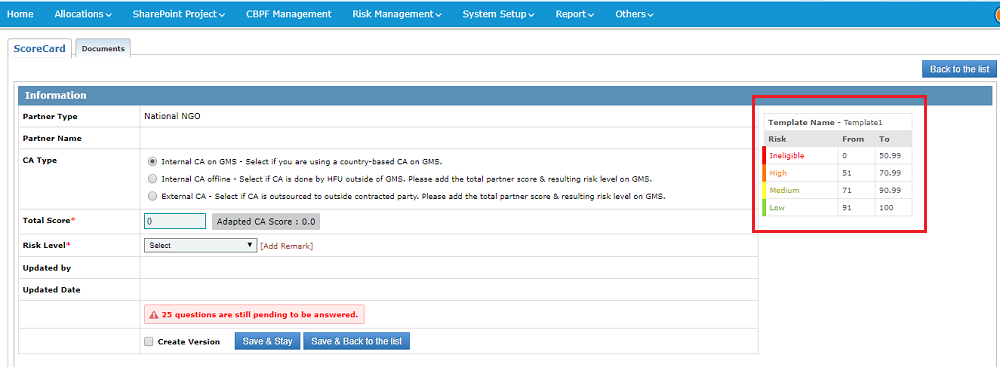
Example: In our example, the partner received a CA total score of 76.75. According to the country CA scale provided in the table on GMS, this score is within the 71 to 90.99 score range, corresponding to ‘Medium’ risk. Therefore, the Partner has a Medium Risk Level.
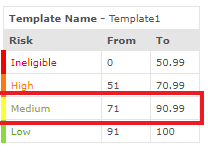
B. What is the adapted CA score?
The Adapted CA score is displayed next the CA score automatically calculated at the completion of the CA Questionnaire on GMS.

The adapted CA score was introduced to harmonize the CA scores and to facilitate the comparison of partners’ risks between funds.
It is calculated by means of a ‘multiplier’. The ‘multiplier’ is specific to each Fund; it translates the CA country score into its weight equivalence at the global level without changing the risk level
It is the adapted CA score which is used in the calculation of the Partner Performance Index Adjusted Risk Level.
For instance:
Lebanon’s HIGH Risk range is scored between 31 and 70.99, and the global HIGH Risk range is scored between 50 and 69.99.

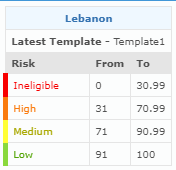
Partner Z is scored 31/100, which is considered Eligible/-HIGH Risk according to Lebanon’s range.
A score of 31 would be considered ineligible at Global level without the multiplier concept.
However, with the multiplier concept, the equivalent score at the global level is 50/100, which is considered as Eligible - HIGH risk. Partner Z’s Adapted CA score is hence 50/100 and reflects the correct Risk Level on the global template.
| To learn more on Capacity Assessment scoring and how to calculate it on the GMS, please refer to this article of the Help Portal. |
3/ Performance Index score
The performance of an Implementing Partner on a project is assessed through a set of questions, pre-determined by the CBPF and common to all partners. These questions are displayed for the HFU as and when specific milestones are completed in the project lifecycle.
At Project Closure, when all questions have been answered and saved, the Performance Index score is calculated based on the following weightage:
PARTNER-LEVEL PERFORMANCE AND RISK RATING EVOLUTION
The different project PI scores of a Partner are combined with the original Capacity Assessment’s score to determine the overall Partner PI adjusted score.
The weightage of each project in calculating the overall Partner Performance Index is adjusted as and when the partner completes more projects, i.e. an increased weightage is given to the performance based on the most recent projects completed by the partner.
An overview on how the weightage breaks between Capacity Assessment and Performance Index is given below:

As can be seen in the above screenshot, the CA score is not included in the calculation of the PI adjusted risk from the partner’s fifth project onwards.
The Partner’s PI adjusted score, obtained by the combination of project’s PI scores and CA results (if relevant), is linked to a specific risk level defined by the Global Risk Range, as shown in the screenshot below.
To be included in the calculation of the PI adjusted risk, the CA risk score is adapted from the Country Risk Range to the Global Risk Range via a multiplier tailored for each country.
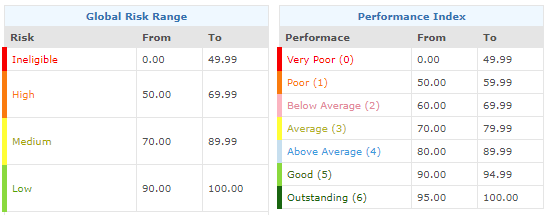
The GMS automatically calculates and determines the Partner’s PI score and subsequent Risk Level (adjusted or not). HFU officers can approve the PI adjusted risk of the Partner from the Partner Performance Index Risk Management page.
| To learn more on Performance Index please refer to this article of the Help Portal. |
4/ When is it recommended to re-calculate the risk level of partners on GMS?
We advise HFU staff to re-calculate the risk of Partners before each allocation, in order to reflect their correct risk level before the approval of their projects.
Since the project requirements are linked to the Partner’s risk level (except UN Agencies, which do not have a risk level), the Partner’s new risk level must be calculated to capture the correct reporting/monitoring requirements and disbursement tranches percentages before linking them in the Timelines’ tab of their approved projects.
To learn more about project requirements and risk level, please refer to our article in the Help Portal on Operational Modalities.
To re-evaluate a Partner’s Risk Level, please follow this navigation: Risk Management -> Partner Risk Dashboard. (1)
After filtering out the Partner (2), click on the barometer icon ![]() (3).
(3).

The Partner Performance Index Risk Management Page allows HFU to see the current Risk Level of the Partner, as well as a history of the risk level calculations. The GMS will indicate if the Risk level requires to be updated or not. The HFU can then agree or disagree to make the change on the system.

5/ What is the difference between Project Risk Level and Partner Risk Level?
The Project Risk Level is the Risk Level that the Partner has when the project reaches ‘Budget Cleared’. It is based on this Project Risk Level that the operational modalities are picked up and linked in the Timelines. You can find the Project Risk Level in the Timelines’ tab of each project.
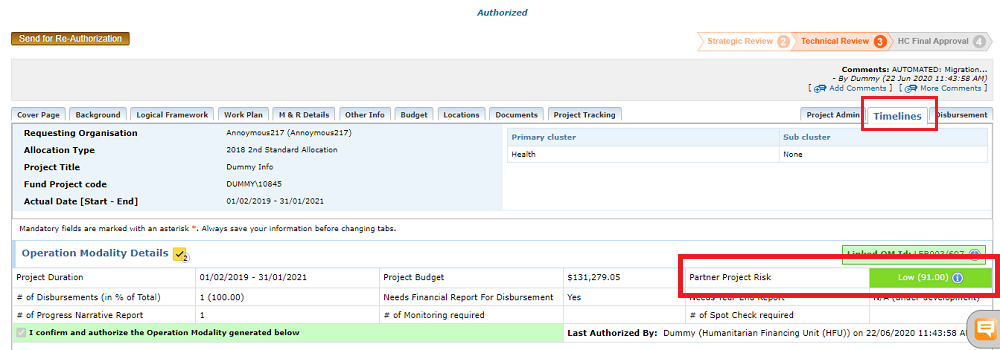
The Partner Risk Level is the current, adjusted Risk Level of the Partner. It can differ from its last approved Project Risk Level provided it has been re-calculated. The Partner Risk Level, along with a history of the risk level re-calculations, can be found on the Partner Risk Management Dashboard.
